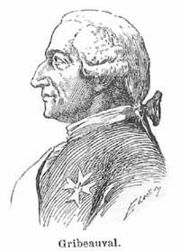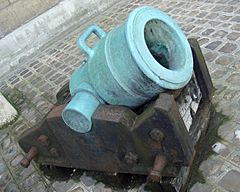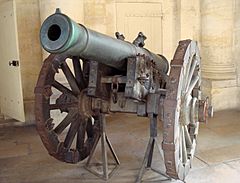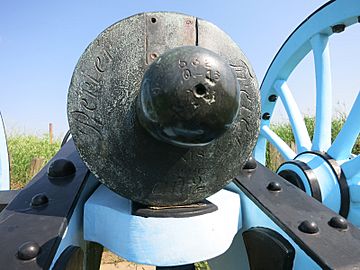Gribeauval system facts for kids
Quick facts for kids Gribeauval system |
|
|---|---|

Gribeauval system field artillery gun barrels are shown. From left to right, they are 12-, 8-, and 4-pounders.
|
|
| Type | Artillery |
| Place of origin | |
| Service history | |
| In service | 1765–1829 |
| Used by | France, French satellites |
| Wars | American Revolutionary War French Revolutionary Wars Napoleonic Wars |
| Production history | |
| Designer | Jean Baptiste Vaquette de Gribeauval |
| Designed | 15 October 1765 |
The Gribeauval system was a new way to make and use cannons and other big guns in the 1700s. It was created by a French general named Jean Baptiste Vaquette de Gribeauval. This system made French cannons much better. They became lighter and more alike, but could still shoot just as far.
This new system changed how France fought wars. It helped them win many battles during the French Revolutionary Wars and the Napoleonic Wars. The Gribeauval system included improvements for cannons, howitzers, and mortars. It was used from 1765 until 1829, when a newer system took its place.
Contents
How the Gribeauval System Was Developed
In the middle of the 1700s, armies wanted cannons that could move faster on the battlefield. Engineers found ways to make gun barrels lighter. Other experts designed lighter carriages for the guns. They also made all cannons of the same type exactly alike. This made it easier to supply armies with the right parts and ammunition.
Gribeauval was a skilled soldier and an expert in artillery. When his system was introduced, France had the best artillery in Europe. One historian even called it "arguably the best artillery system in Europe at that time."
Making Cannons Better
In 1742, a scientist named Benjamin Robins started using science to improve artillery. Cannons were usually made from bronze, which is a mix of copper and tin. Bronze was lighter and stronger than iron for cannons.
Before, cannons were cast with a hollow center. But this often made the inside of the barrel uneven. In 1747, a new method was invented. A man named Jean Maritz started casting cannons as a solid block. Then, a large machine drilled the hole through the middle.
This new way of making cannons was a big secret at first. But soon, everyone in Europe knew about it. With this method, the hole inside the cannon was much straighter and more exact. This meant less space between the cannonball and the barrel. Less gas escaped when the gun fired. So, a smaller amount of gunpowder could shoot the cannonball farther and more accurately.
Because less gunpowder was needed, experts realized that cannon barrels could be made thinner, shorter, and lighter. This was a huge step forward for artillery.
Learning from Others
During the War of the Austrian Succession, Austria realized its cannons were not as good as Prussia's. So, in 1744, Austria began to improve its artillery. They made lighter cannons and better howitzers. These new guns were very successful. Other countries quickly tried to copy them.
Gribeauval served with the Austrian artillery from 1756 to 1762. This gave him a chance to see these new, improved guns up close. When he returned to France, he was asked to reorganize the French artillery.
France already had a good set of cannons, thanks to Florent-Jean de Valliere. His system had cannons from 4-pounders to 24-pounders. However, they were all very heavy.
The Gribeauval system officially started on October 15, 1765. But some officers, including Vallière's son, did not like the new system. Because of their objections, it took until 1776 for the Gribeauval system to be fully put into use.
Key Improvements of the System
Gribeauval's changes were not just for the cannons themselves. They also included the gun carriages, the parts that connect the gun to the horses, ammunition boxes, and all the tools.
The field guns in the system included:
- 4-pounder cannons
- 8-pounder cannons
- 12-pounder cannons
- 6-inch and 8-inch howitzers
The new gun barrels were shorter and thinner. The gun carriages were lighter and narrower. These changes made the entire artillery piece much lighter. The carriages were also made with parts that could be swapped between different guns. This made repairs and maintenance much easier.
The carriages had two spots for the cannon's pivots (called trunnions). One position was for firing, and another was for moving the gun. Horses were harnessed in pairs, which was more efficient. The guns also got a special sight at the back and a screw to adjust the aim. These two improvements made it much easier for gunners to aim accurately.
Other new ideas were also added. These included special tubes that helped gunpowder ignite better. Gunpowder charges were put into pre-packaged flannel bags. A better gunpowder mix was used. And a special tool called a vent-pricker was used to make a hole in the gunpowder bags. Around 1791, a French chemist found a way to make saltpeter, which is a key part of gunpowder.
Finally, France also opened artillery schools. These schools trained soldiers to become better gunners. This was important because the new guns needed skilled operators.
Types of Gribeauval Guns
Field Guns: Fast and Powerful
The Gribeauval field artillery pieces weighed about half as much as the older Vallière guns. But they could shoot just as far!
- Canon de 12 Gribeauval – This was a 12-pounder cannon.
- Canon de 8 Gribeauval – This was an 8-pounder cannon.
- Canon de 4 Gribeauval – This was a 4-pounder cannon.
- Obusier de 6 pouces Gribeauval – This was a 6-inch howitzer.
It's important to know that the old French pound (livre) was a bit heavier than the English pound. Also, the old French inch (pouce) was a bit longer than the English inch. So, a French 8-pounder cannon was actually similar in power to a British 9-pounder.
| Name | Gun calibre | Gun crew |
Canister range |
Effective range shot |
Maximum range shot |
Rate of Fire per minute |
Trail Chest round shot |
Caisson round shot |
Caisson canister shot |
Caissons per gun |
|---|---|---|---|---|---|---|---|---|---|---|
| 12-pounder cannon | 121 mm (4.8 in) |
15 | 575 m (629 yd) |
900 m (980 yd) |
1,800 m (2,000 yd) |
1 shot | 9 | 48 | 20 | 3 |
| 8-pounder cannon | 100 mm (3.9 in) |
13 | 475 m (519 yd) |
800 m (870 yd) |
1,500 m (1,600 yd) |
2 shots | 15 | 62 | 20 | 2 |
| 4-pounder cannon | 84 mm (3.3 in) |
8 | 375 m (410 yd) |
700 m (770 yd) |
1,200 m (1,300 yd) |
2–3 shots | 18 | 100 | 50 | 1 |
| 6-inch howitzer | 166 mm (6.5 in) |
13 | 200 m (220 yd) |
700 m (770 yd) |
1,200 m (1,300 yd) |
1 shell | 4 | 49 | 11 | 3 |
| Name | Barrel Length | Barrel Weight | Carriage Weight | Round Shot Charge Weight |
Large Canister Balls per Round |
Small Canister Balls per Round |
Canister Round Charge Weight |
|---|---|---|---|---|---|---|---|
| 12-pounder cannon | 7 feet 7 inches (2.31 m) | 2,172 lb (985.2 kg) | 2,192 lb (994.3 kg) | 4 lb (1.8 kg) | 41 | 112 | 4.25 lb (1.9 kg) |
| 8-pounder cannon | 6 feet 7 inches (2.01 m) | 1,286 lb (583.3 kg) | 1,851 lb (839.6 kg) | 2.5 lb (1.1 kg) | 41 | 112 | 2.75 lb (1.2 kg) |
| 4-pounder cannon | 5 feet 3 inches (1.60 m) | 637 lb (288.9 kg) | 1,454 lb (659.5 kg) | 1.5 lb (0.7 kg) | 41 | 63 | 1.75 lb (0.8 kg) |
| 6-inch howitzer | 2 feet 4 inches (0.71 m) | 701 lb (318.0 kg) | 1,895 lb (859.6 kg) | 1.0625 lb (0.5 kg) | 60 | none | not stated |
Canister shot was a special type of ammunition. It was a metal can filled with small iron balls. When fired, the can broke open, and the balls spread out like a giant shotgun. This was very effective against groups of enemy soldiers. The size of the balls in the canister varied depending on the cannon's size.
Siege and Garrison Guns: For Forts and Cities
Gribeauval also kept some of the older, heavier cannons for attacking forts (siege guns) or defending them (garrison guns). He made them simpler by removing fancy decorations.
- Canon de 24 Gribeauval – A 24-pounder siege cannon.
- Canon de 16 Gribeauval – A 16-pounder siege cannon.
- Canon lourd de 12 Gribeauval – A heavy 12-pounder siege cannon.
- Canon lourd de 8 Gribeauval – A heavy 8-pounder siege cannon.
These heavier guns were likely used by French forces during the American Revolutionary War. For example, at the Siege of Yorktown in 1781, French forces used many large cannons and mortars.
Mortars: High-Angle Firepower
Gribeauval also designed a range of mortars. Mortars are short, wide-barreled guns that shoot shells high into the air. This allows them to hit targets behind walls or hills.
- Mortier de 12 Gribeauval – A 12-inch mortar.
- Mortier court de 10 Gribeauval – A short 10-inch mortar.
- Mortier long de 10 Gribeauval – A long 10-inch mortar.
- Mortier de 8 Gribeauval – An 8-inch mortar.
He also included a very large 15-inch stone mortar from the older system. These mortars and the largest siege cannons were moved using special "saddle wagons."
| Name | Weight of Mortar | Weight of Carriage | Weight of Charge |
|---|---|---|---|
| 12-inch mortar | 3,150 lb (1,429 kg) | 3,000 lb (1,361 kg) | not stated |
| Long 10-inch mortar | 2,050 lb (930 kg) | 2,616 lb (1,187 kg) | 6.5 lb (2.9 kg) |
| Short 10-inch mortar | 1,600 lb (726 kg) | 1,739 lb (789 kg) | 3.5 lb (1.6 kg) |
| 8-inch mortar | 550 lb (249 kg) | 820 lb (372 kg) | 1.25 lb (0.6 kg) |
The Gribeauval System in History
During the early French Revolutionary Wars, the artillery branch of the French army kept most of its officers. This was because many of them came from middle-class families, not rich noble families. Thanks to the Gribeauval system, French field artillery was the best in Europe.
However, the artillery still had a problem. Civilian drivers and horses were hired to move the guns. This meant they weren't always reliable. This problem was fixed after 1800 when the drivers became soldiers.
At the Battle of Jemappes in 1792, France's better artillery helped them win. The general, Charles François Dumouriez, said that French soldiers fought harder when their cannons were winning. If the artillery wasn't doing well, the infantry would hold back. One observer after the Battle of Wattignies in 1793 said the French victory was because of "their immense artillery."
Napoleon Bonaparte became famous partly because of his excellent use of artillery. He was promoted to general after his skilled handling of cannons at the Siege of Toulon in 1793. When Napoleon became the leader of France, he asked Auguste de Marmont to make more improvements to the artillery.
By 1800, France had many artillery units, including gunners, engineers, and drivers. They had a total of 28,000 soldiers. At first, each infantry unit had some 4-pounder cannons. These were called regimental artillery. They were removed in 1800 but brought back in 1809. Napoleon also wanted to replace the 4-pounders with 6-pounders. This would make his artillery more powerful. He could do this because France had captured many 6-pounders from Austria and Prussia.
From 1805, a new system called the Year XI system started to replace some Gribeauval guns. The Gribeauval 4- and 8-pounders were slowly replaced by the Year XI 6-pounder. The Gribeauval 6-inch howitzer was replaced by the Year XI 24-pounder howitzer.
However, the new Year XI 6-pounder turned out to be too weak. In 1810, a group of experts decided that the Year XI system should be stopped. They wanted to keep the Gribeauval system, but also introduce a new 6-pounder. After Napoleon's rule, the 4- and 8-pounders were brought back into service.
In 1829, the Gribeauval system was completely replaced by the Valée system. This new system, designed by Sylvain Charles Valée, made artillery even more mobile. Gunners could now ride on the limbers (the front part of the gun carriage) instead of walking. This made the artillery much faster on the battlefield.
Images for kids











